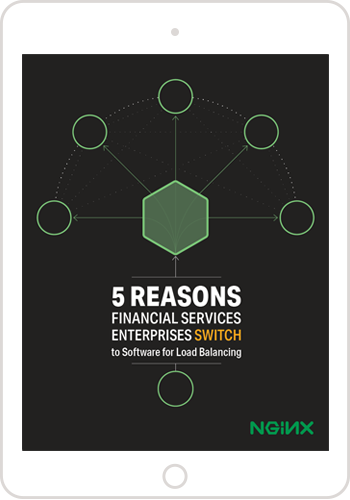By Megan DeGruttola, Black Duck Software
This article was originally posted on Black Duck Software’s blog.

NGINX, Inc. is known for its open source, high‑performance HTTP web server. With its new NGINX Plus Release 6 (R6) and a growing number of third‑party tools being built on top of its platform, NGINX is continuing to expand well beyond web servers.
Participating as a Platinum collaborator in the 2015 Future of Open Source Survey, NGINX CEO, Gus Robertson, shared his perspective on this year’s survey and how he sees NGINX and the open source industry evolving.
This year’s Future of Open Source results proved the pervasive use of open source by organizations, with 78% saying their companies run part or all of their operations on OSS. Is this something you’re seeing at NGINX?
 Gus Robertson: When I first started in the industry, open source was the “new thing,” the alternative option. Now it’s becoming much more of the standard. In large‑scale web applications, like Airbnb, Eventbrite, and Netflix, it’s predominately open source with very little proprietary technology.
Gus Robertson: When I first started in the industry, open source was the “new thing,” the alternative option. Now it’s becoming much more of the standard. In large‑scale web applications, like Airbnb, Eventbrite, and Netflix, it’s predominately open source with very little proprietary technology.
Most companies are using open source for a number of reasons. Sometimes the initial attraction is cost effectiveness, but that’s not usually the overall reason companies move towards open source. It’s simply a better software development model. Many eyes make for fewer bugs – and increasingly greater innovation – in the code.
More so now than ever, using open source is a good way to attract top talent to your organization. The companies we work with want to be very vocal about using tools like NGINX because it shows they’re forward thinking and using progressive technology. The more advanced talent they can attract, the more creative solutions they’ll get from the developers and engineers they bring into their organization.
A large number of companies are now actively participating in the open source community, with 64% reporting they currently participate in OSS projects. How have you seen this progression from corporate open source consumption to community contribution?
Gus: I’ve actually seen it go even further than that. Companies have recently been moving past simply participating in open source to actually leading and implementing their own open source projects.
We are working with two Fortune 500 companies that are collaborating on a solution they plan to open source in the next few months. Both were trying to independently solve a similar problem and, after learning about each other’s efforts at a conference, decided to share their work.
It’s a natural evolution. If companies are participating in open source to attract talent, it makes sense that those same developers are going to want to continue contributing back to the community.
Open source is inherently cost effective and flexible, but the Future of Open Source has progressively shown OSS is viewed as superior in other areas like ability to scale, competitive features, and security. What are the most common benefits your customers are seeking from open source when they come to NGINX?
Gus: There was a turning point about seven years ago when open source started to become the superior solution. There was a community of developers who weren’t just contributing code, but also testing it and pushing the edges of what was being built. When you combine that with the agile method, you end up with a superior code base and a better product. Plus, the number of engineers who actually touch the code in these large, community‑driven projects are generally an order of magnitude greater than what a proprietary vendor could ever staff.
 The bias ten years ago was that you only used open source if you wanted to be able to modify the code. Today, what attracts people to NGINX is the fact that it’s simply superior, high‑performance software. Our customers also happen to like that it’s open and transparent, whether or not they ever intend to alter the code.
The bias ten years ago was that you only used open source if you wanted to be able to modify the code. Today, what attracts people to NGINX is the fact that it’s simply superior, high‑performance software. Our customers also happen to like that it’s open and transparent, whether or not they ever intend to alter the code.
There also used to be a question around the security of open source, but even the U.S. Department of Defense has said open source is more secure because you can actually perform rigorous and continuous security threat analysis on the code that’s out there.
We featured NGINX’s Discovery Education case study this year’s results presentation. Is that a typical example of the challenges organizations are facing when they come to NGINX?
Gus: What was happening at Discovery Education is something we see in a number of customers. A lot of organizations have monolithic application stacks that were designed five or more years ago and are unable to handle growing traffic demands. As a result, very expensive, hardware‑based load balancer appliances became band‑aid solutions to solve that problem. We help companies move from these types of hardware tools to software tools, typically as the company is beginning to modernize their application architecture.
As far as Discovery Education was concerned, they were looking for improvements beyond load balancers. A core part of their business is streaming media. Therefore, they became very interested in our HTTP streaming media solution which is high‑performing, very reliable, and akin to what Netflix is doing with their streaming services.
You recently released a new version of NGINX Plus. Tell me about the main features driving that release.
Gus: There is an underlying trend that drives NGINX adoption, which is at the convergence of three market factors: the adoption of the DevOps model, the move to cloud, and containerization.
The fundamental architecture inside the enterprise is changing. We are starting to adopt more software‑defined networks and infrastructures. There is a growing focus on letting the developer define how an application gets delivered, and this really drove a lot of the new features in R6 and our latest open source release.
We’ve had overwhelming demand from our customers to expand our load balancing management beyond their modern applications to also cover legacy applications using TCP as the protocol. At the same time, we are continuing to build out our monitoring and management capabilities inside of the product to provide visibility into what’s going on inside these applications.
Just last week, Mashape announced its Kong open source management layer for APIs, built on top of NGINX. How do you work with Mashape and other partners building tools on your platform?
Gus: We see NGINX becoming a platform for a range of different solutions. As such, we actively work with the folks at Mashape and a number of other partners that are building tools and solutions on top of the NGINX platform.
For example, Alcatel Lucent delivered their communications platform, OpenTouch, on top of NGINX. And Illumio delivered their security platform for NGINX. We’ve also worked with a lot of the application performance management companies, like New Relic, to integrate NGINX into their management and visualization platforms. We’re proud to be supporting a range of different third‑party solutions.
What do you see open source software evolving in the future?
Gus: It all started with the operating systems and it just continues to evolve as you go up the stack – from storage and virtualization to middleware and cloud – there is no part of the software industry that’s safe from open source. It’s largely driven by developers and they want to open source their solutions.
Companies can either get on board with open source or spin their wheels trying to hold it back. Organizations like NGINX and our partners are very supportive of developers and are trying to drive greater adoption of open source.


